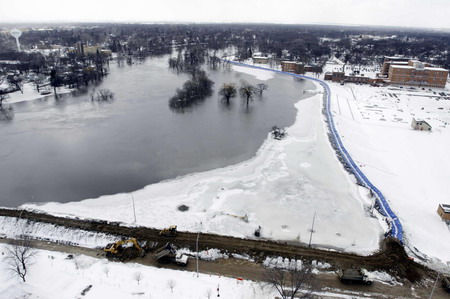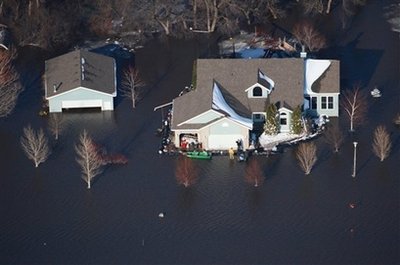Some 1,700 National Guard troops helped reinforce the dikes and conduct patrols for leaks. Police restricted traffic to allow trucks laden with sandbags, backhoes and other heavy equipment to get through.
 |
|
Dump truck loads of clay are added to a permanent dike that protects downtown Fargo, North Dakota March 27, 2009. [Agencies]
|
Guard member Shawna Cale, 25, worked through the night on a dike, handing up sandbags that were 30 to 40 pounds and frozen-solid.
"It's like throwing a frozen turkey," said sister-in-law Tawny Cale, who came with her husband to help with the sandbags and then to help Shawna move her valuables as she evacuated.
"When it hurts when you lift your arms, you have to stop," Shawna Cale said.
City Administrator Pat Zavoral said the cold firms up the bags, strengthening the dikes. "If you lay loose bags and now they're frozen, they're like a frozen ice cube. It's good shape."
Authorities said they were keeping about 300,000 of the 3 million sandbags they had Friday in warm buildings for use as needed. Sandbags that are already frozen when piled onto a dike do not fit together snugly.
|

Homes along the Wild Rice River in South Fargo, N.D. near its confluence with the Red River, are seen, Friday, March 27, 2009. [Agencies] |
But the freezing temperatures actually helped stave off worse flooding; officials said the river was rising more slowly because the freezing temperatures prevented snow from melting.
The White House said it was monitoring flooding in North Dakota and Minnesota, and President Barack Obama has dispatched the acting head of the Federal Emergency Management Agency to the region. White House spokesman Robert Gibbs said Obama has personally spoken with the governors of both states and with Fargo's mayor.
The president called North Dakota Sen. Kent Conrad on his cell phone during a news conference in Bismarck on flooding problems there and in Fargo. "If there's anything more that we can do, we will do it," Obama said after Conrad held the phone up to a microphone.

